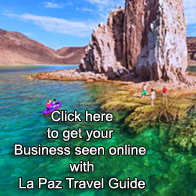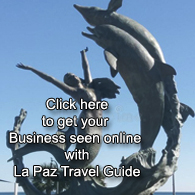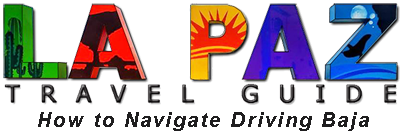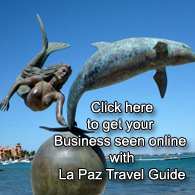
 |
<<<RETURN TO HOME PAGE | PHOTOS OF LA PAZ |
   |
 |
   |
|
||
Having crossed both border crossings the Tijuana crossing is straightforward coming out of southern San Diego on I-5. once you cross you take the "loop" out to the Playas and follow the signs leading to the Playas which will take you on to the toll road which goes from Tijuana to Ensenada and is a 2 lane each way highway with turn offs to many small towns along the 70 mile stretch between the Tijuana and Ensenada. After following the signs thru Ensenada for hwy , you are lead south onto a fair to poorly maintained road that is two lanes wide (one each way) and narrow. It is a curvy, hilly and not recommended for novice RV drivers road with Semi trucks taking more than their share of the road on straights and the curves which can make it dangerous. Many an RVer have lost a side mounted mirror (including the author of this article) to a Semi truck taking more than its share of the road. Most of this stretch of hwy 1 from Tijuana to Guerro Negro has little to no shoulder and a 2 to 6 ft drop off the none existent shoulder which would leave any RV or trailer rolling if they left the road to avoid the near collisions with the Semi 18 wheeler trucks. I personally have driven a Jeep, Panel van, Pickup truck and vehicle pulling a trailer down hwy 1 from Tijuana and found it o.k. on many of those trips if traveling during a Sunday early morning, when the 18 wheelers are not using the road as much. driving this part of hwy 1 at night is just plain suicide. With the new hwy 5 being completed a number of years ago, with its wide lanes and flat well maintained surface it is the only way to go if you are traveling with a trailer or driving an RV. Going across the mountains from San Diego is the only real pain and is an 80 mile crossing to get to the Mexicali border crossing. You will find two crossing points. the West border crossing where most all vehicles cross and the East crossing where many if not all RVs cross. I have found it easier to get your tourist card by crossing the West border crossing, as you will have to drive back to the west crossing area to get it anyway if you cross at the East Crossing.. but here is the kicker, having to use the East crossing for your RV it is easier to cross with little to no hassle from the border if you know when and what time to cross. I crossed with my RV (34ft Class A motorhome) the last few times at the East Gate and did it at 6am on a Sunday morning (the East gate is closed from 11pm to 6am) and being first in line gets you a wave thru and not much more. Take the first Right (although the sign says left for Tourist Visas) turn Right and follow the road along the border to the west gate. Go inside the border building and ask the uniformed guards where to get your tourist card and if all goes well you can pay and have your passport stamped and get your card all in the same office with the same person. then get back on hwy 5 going south and enjoy a nice day of driving along the Sea of Cortez to San Felipe and then continue down hwy 5 until is eventually meets up with hwy 1 north of Guerro Negro. This is about an 8 to 10 hour drive in an RV. Once you make it past Guerro Negro the road is pretty much straight and more forgiving all the way to the 8% grade leading into Santa Rosalia. After going thru Santa Rosalia (lots of places to stop here for just about anything you might need and a good place to get your tank filled before heading to Loreto. you continue long the Sea of Cortez only going thru a few mountains for about 10 miles just before hitting Mulege. Mulege is a small very narrow street town that hasn't changed a bit since the first time I drove thru in 1991. It has a beautiful river area and a fwe small shops and stores.. but beware do not get fuel here (in town or south of town) staying there for about 2 months the pumps are rip offs and one day you can get 1000 pesos and not get even a 1/4 tank in a pickup truck and the next day get 1000 pesos and get a 1/3 tank of gas) either way that $50 US for what should be 3/4 of a tank at $5.00 a gallon! I have since gotten gas in La Paz for the last 6 months and $1000 pesos on dead empty gets you well over a half a tank a gas every time. So enjoy the quaint town of Mulege, just don't get gas there! Do stop at Mago's American Style Bakery and try the homemade award winning Chili. The road out of Mulege winds through some mountains and down to the beautiful bay of Bahia Concepcion. This is a must stop with Playa Santispak being the first of many beach camping stops and the most accessible of all of them. the view coming over the last hill and seeing the bay for the first time is well worth the previous 12 to 14 hrs on the road from the border. From late March thru late October the water is perfect. you can wade out 100 yards and still be in only waist to chest deep water and see the white sand bottom. Snorkel down or simply bend over and grab some clams and scallops. There is a great seaside restaurant called Armondo’s which offers live music on Friday nights and some great food. After Playa Snatispak you will come across some condos for rent, Playas Burro and Coyote and then a climb up some mountainous road way and along the rest of Bahia Concepcion until turning into some great desert scenery as you approach Loreto. the road way between Mulege, Bahia Concepcion to Loreto can be comparable to that of hwy 1 south of Tijuana and is curvy, hilly and a little dangerous. From the border to Loreto you will have crossed anywhere from 3 to 6 military checkpoints. going south they are less intrusive and will usually just take a fast look and let you on your way, having a cold coke and some snacks to give them will usually speed things up considerably. going north they are much more involved in looking for drugs and or guns as most of this stuff comes from the south going north. I found the check stop north of Loreto the most strict in looking for stuff. So just be polite, give them a smile and be patient and you will be on your way after 5 to 10 minutes of checking your stuff. Again having a cold soft drink or water and a snack goes a long way in getting your check done a little quicker. After Loreto it is unusual to have another check point. Do not stop unless these checkpoints are manned by uniformed soldiers. All check stops are pretty much permanent out post so seeing something that doesn't look right and is not manned by gun toting uniformed military personnel means something probably isn't' right and could be a fake check point where unauthorized personnel are trying to get money from you or worse, so be vigilant. Once you leave Loreto you have one last dangerous piece of road to navigate and that it the hill climb south of Loreto. It is steep, curvy as it gets and narrow in many places. but going south is much easier than going north and having to go down this very steep 30km long ski ramp with more turns than you can count... if driving a large truck, semi, RV or towing a trailer do a really REALLY good brake check before taking on this monster. Once you get to the high desert there are straight roads for most of the rest of the drive to La Paz and the closer you get the more modern the roads are and the shoulder size increases from a few inches to 5ft or more in some areas. There is at times a Federally car stop just north of La Paz but most the year it is closed with no one manning it. Once you get to La Paz the first signs of a modern city appear with Walmart, Home Depot, Carl's Jr. and Sam's Club all at the outskirts of La Paz. To continue to Cabo San Lucas, as you come into La Paz and get to the Dove and Arch (many think it's a whale's tail, as I did for a number of years) you can go right into La Paz and towards Walmart or go left towards Home Depot and Cabo. Once you go Left at the split, continue to the first light (not stop sign but light) and work your way over to the right lane while getting there (about 400 yards) from the split off. At the light take a right and take the road way around town staying on it to the next light, which is past the two 4 way stops you have to go through. At the next light you will notice a major intersection. Go right here and you will be back on hwy1 and heading towards Cabo San Lucas. You take this for about 20+ miles and it then has a turn off onto hwy 19. Take hwy 19 for a 4 lane freeway all the way to Cabo and a regular U.S. style highway (although watch out of goats and cattle crossing at any time and any place) you can also continue thru to hwy 1 which takes you to the East cape and the towns out there, but adds an hour plus to your travels and is a much curvier road and narrower. Hwy 19 also goes by the town of Todos Santos. You will also enjoy driving along the cool Pacific Ocean coast of Baja. As you finally get to Cabo the city has grown considerably since the 1990s and is now a large city versus the small sport fishing town it once was.. Costco, Walmart, and most all American fast food have made it into Cabo. The Baja Peninsula is a very cool drive and very safe if you plan it right and don't go faster than your driving skills allow you to go. Nearly 100,000 tourist vehicles make the drive each year and taking some helpful hints from someone who has driven the Baja over 100 times in all sorts of vehicles can make your drive down the Baja fun and enjoyable and memorable. |
||
|
||
| La Paz Travel Guide Ⓒ 2022 | Contact Us |